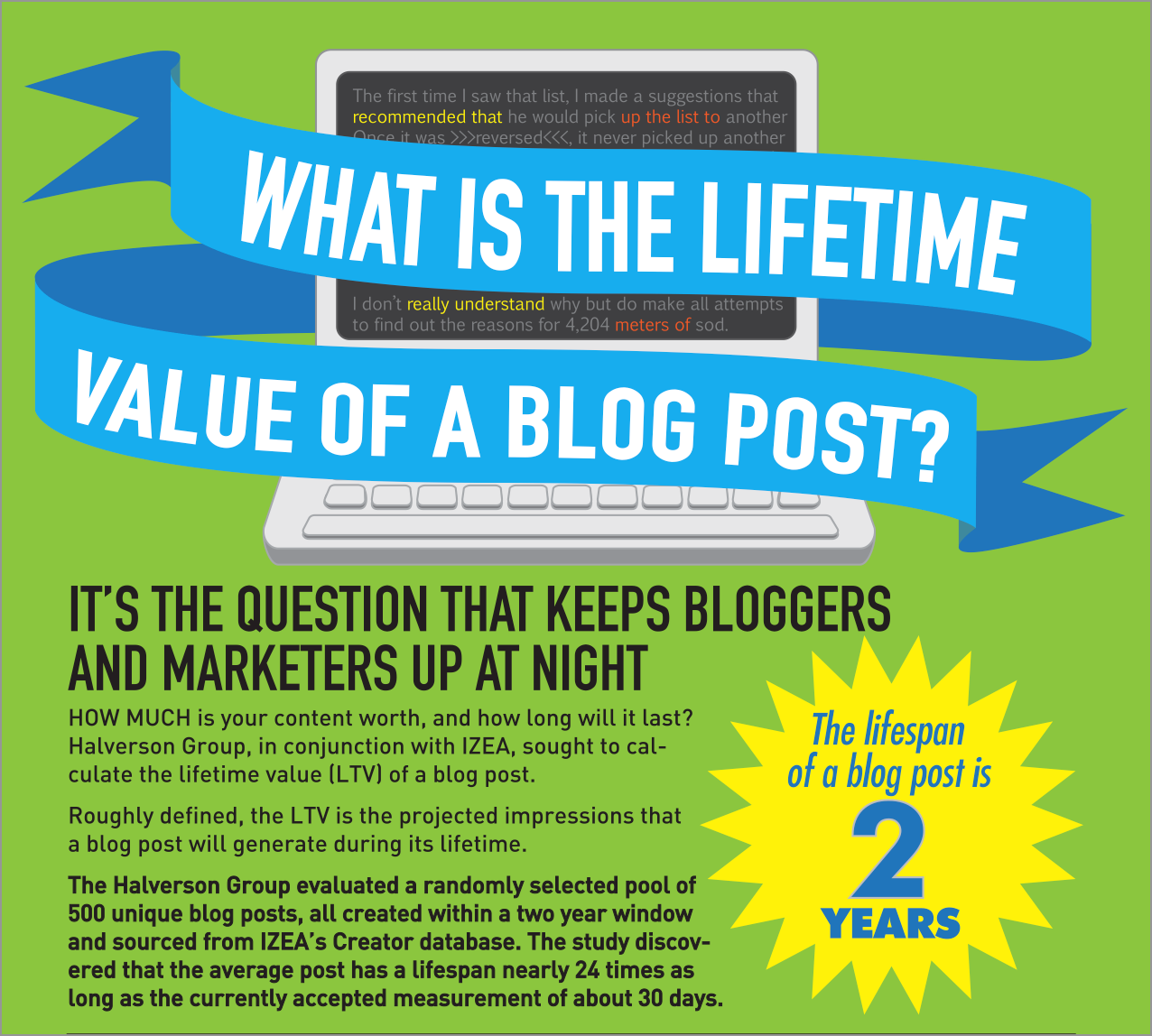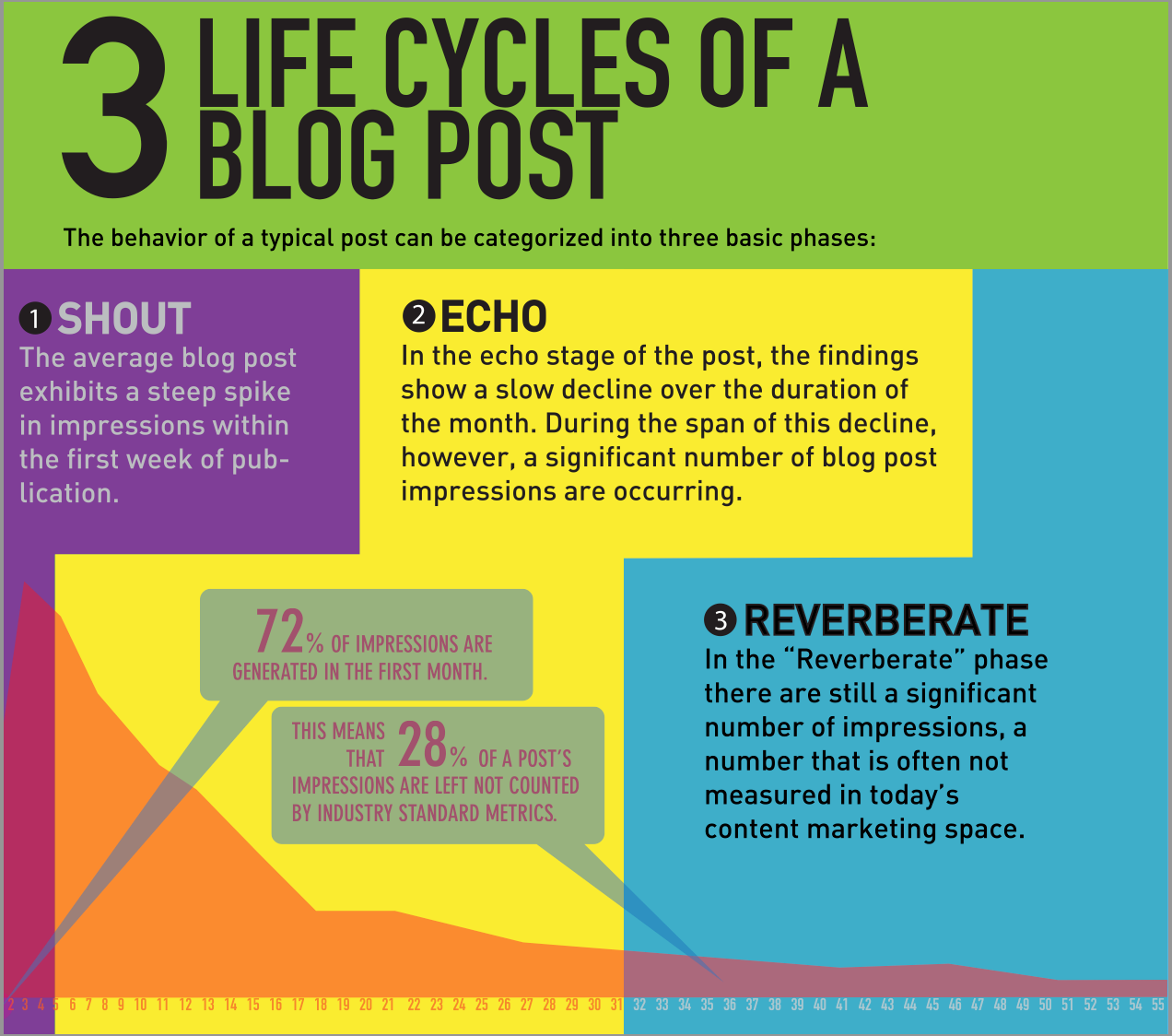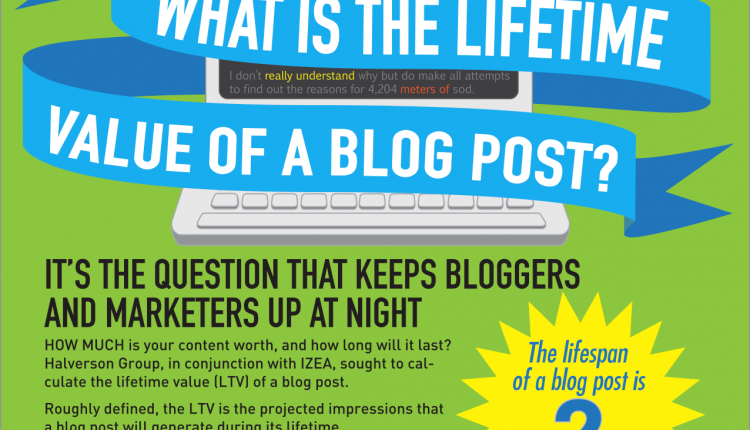When evaluating the effectiveness of our content marketing efforts, one of the most difficult metrics to pin down can be lifetime value. When you’re talking about a blog post in particular, which can lack the “stickiness” of infographics, charts or webinars, estimating life cycle gets even trickier.
For years, the industry rule of thumb has been that most blog posts have a life cycle of approximately 30 days. What methodology led to this 30-day theory? Was it just a random guess based on some marketer’s gut feeling or anecdotal observations? Who knows.
Our Florida neighbors to the south, IZEA, recently commissioned a study to scientifically measure just what the lifetime value of a blog post really is. With the help of the Halverson Group, 62,863 blog posts were gathered, of which 500 were randomly sampled.
When tracking the performance of these posts over time, the Halverson Group made three very interesting discoveries.
Discovery #1. The lifetime value of a blog is much longer than originally believed

Flint McGlaughlin, CEO and Managing Director of MarketingExperiment’s parent company, MECLABS Institute, has a saying that he is particularly fond of: “Best practices are often nothing more than pooled ignorance.”
In the case of the widely accepted 30-day life cycle of the blog post, Flint’s statement rings true.
When calculating impressions, the team found that the lifecycle of a blog post isn’t 30 days, 30 weeks or even a year. What the study discovered is that the lifetime value of a blog post is actually two years. This finding suggests that blog posts hold much more value, over a much longer time period, than even we marketers who are already sold on the power of blogging believe.
“Long-form content, such as blog posts created by influencers, are one of marketers’ most effective and cost-efficient tools today. This study has pulled back the layers so that both content creators and marketers alike can realize the full value of this content and contrast it against the other mediums in which they invest,” said Ted Murphy, CEO, IZEA. “With lifespan nearing two years, blog content and content marketing programs that leverage blogs have an evergreen value affect — especially when compared to volume-based media, such as display or search advertising, which stop delivering value as soon as the campaign investment ends.”
Discovery #2. Blog posts have three distinct phases of life

Throughout the course of the study, the IZEA team discovered that the majority of blog posts experience three different stages throughout their life cycle: shout, echo and reverberate.
Shout: The “Shout” phase yields an initial steep spike in impressions that occurs within the first week to 10 days, when 50% of a blog post impressions are generated.
Echo: The “Echo” phase begins shortly thereafter and lasts until day 30, when 72% of blog post impressions are realized.
Reverberate: The “Reverberate” phase makes up the 28% of remaining impressions and lasts days 30-700. The Reverberate Phase is important for both content creators and marketers as that is where the long-tail value occurs.
Discovery #3. The expected lifetime impressions of a blog post can be calculated

As an economics guy, I’m always a fan of a good multiplier. In the case of blog posts, IZEA believes that the magic multiplier is approximately 1.4x.
According to the team, multiplying our blog post’s first month pageviews by 1.4x should give us a decent approximation of the total views the post will experience during its life cycle. Obviously, the digital world is ever-changing, and a lot of things can happen in two years, from changes to search engine algorithms and number of backlinks, to additional promotion and a sudden spike in interest in a certain topic. However, the 1.4x multiplier should serve as a good baseline.
Testing the multiplier with the MarketingExperiments blog post
To test IZEA’s findings myself, I randomly selected three old MarketingExperiments blog posts and hit Google Analytics.
How did the multiplier hold up?
Through this admittedly non-scientific experiment, I discovered that our blog posts actually have an even longer tail than IZEA’s research suggests.
For the handful of posts that I looked at, I discovered that the 30-day multiplier for each was actually well above 2.0x.
For example, “A/B Testing: 3 resources for copywriting and call-to-action optimization,” a July 2012 post by Daniel Burstein, Director of Editorial Content, MECLABS Institute, had a multiplier of 2.5x, with the expected initial spike followed by an incredibly long tail comprising nearly 60% of total views.
The bottom line
Though we all have our own unique blogs, with unique audiences, unique promotional tactics and unique multipliers, if there’s one thing that IZEA’s study proves, it’s that our blogs may have even more lasting value than we realize.
When possible, we shouldn’t write our blog posts just for today’s audience but also for next month’s audience, next year’s audience and even the audience that will still be making their way to our posts two years from now during the “Reverberate” phase.
Make those posts count, bloggers.
They’re a thing.
You can follow Ken Bowen, Managing Editor of MarketingExperiments, MECLABS Institute, on Twitter at @KenBowenJax.
You might also like
Optimizing Calls-to-action: 4 questions to ask yourself while writing a CTA
Blog Analytics: How do you measure the company blog’s performance?
Content Marketing: An 8-point analysis for your blog [From MarketingSherpa Blog]





Thanks Ken for this article. Managing visitors on a blog post or any content piece for a healthy time period is difficult, however if promoted it strategically during reverberate period, it fetched good results. One of the key factors is to remember the insights of the content and keep sharing it at relevant places. Submitting meaningful article on platforms having relevant visitors will keep the impression of content intent. Make sure that it is shared on social media at regular intervals with different but meaningful teasers. It is all about art of marketing that keeps your content visible. Look at the article that gives idea about art of marketing http://bit.ly/1UvWoTe